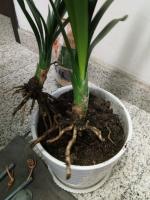How Tall Can a Roma Tomato Plant Grow?
Tomatoes are one of the most popular vegetables (or fruits, depending on how you classify them!) grown in home gardens. They come in many varieties, with different colors, sizes, and shapes. Roma tomatoes are a popular choice for those who love making sauces and canning tomatoes. But how tall can a Roma tomato plant actually grow?
The Basics of Growing Roma Tomatoes
Roma tomatoes are determinate varieties, meaning they grow to a set height and then stop. This makes it easier to control the plants and harvest the fruit. Typically, Roma tomato plants will grow to be about 3-4 feet tall. However, with proper care and growing conditions, they can potentially get a little taller.
When growing Roma tomatoes, it's important to space the plants out properly to allow for adequate air circulation and prevent disease. Space plants about 24-36 inches apart, depending on the variety. Roma tomatoes prefer full sun and well-draining soil. Make sure to water evenly and deeply, but avoid overhead watering to prevent disease.
Potential Height of Roma Tomato Plants
While Roma tomato plants typically grow to be about 3-4 feet tall, some gardeners have reported plants reaching 6 feet or more! This is not common, but it can happen with ideal growing conditions, such as plenty of sun, water, and enough nutrients.
In general, it's important to try to keep tomato plants from getting too tall, as it can lead to weaker stems and potentially breakage. If you notice your Roma tomato plants getting taller than desired, you can prune off the top growth to help control the height. Some gardeners even prefer to prune their tomato plants to create bushier, more compact plants.
Other Considerations for Roma Tomato Plants
In addition to proper spacing, sun exposure, and watering, there are a few other considerations to keep in mind when growing Roma tomato plants. One is fertilization. Tomatoes are heavy feeders and require plenty of nutrients to grow and produce fruit. Consider using a balanced fertilizer or compost to ensure your plants are getting what they need.
Another consideration is pest control. Tomatoes are prone to a variety of pests and diseases, including tomato hornworms, aphids, and blight. Signs of pest infestation can include holes in the leaves, brown spots, or stunted growth. It's important to catch and treat pests early to avoid widespread damage.
Conclusion
Roma tomatoes are a popular choice for home gardeners who love to cook and preserve their own food. While these plants typically grow to be about 3-4 feet tall, with ideal growing conditions they can potentially reach 6 feet or more. Proper care, including spacing, sun exposure, watering, fertilization, and pest control, can help ensure healthy plants and a bountiful harvest.

 how many times do yo...
how many times do yo... how many planted tre...
how many planted tre... how many pine trees ...
how many pine trees ... how many pecan trees...
how many pecan trees... how many plants comp...
how many plants comp... how many plants can ...
how many plants can ... how many plants and ...
how many plants and ... how many pepper plan...
how many pepper plan...































